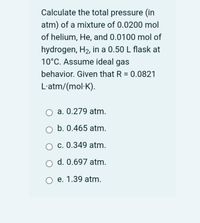
Chemistry
10th Edition
ISBN: 9781305957404
Author: Steven S. Zumdahl, Susan A. Zumdahl, Donald J. DeCoste
Publisher: Cengage Learning
expand_more
expand_more
format_list_bulleted
Question

Transcribed Image Text:Calculate the total pressure (in
atm) of a mixture of 0.0200 mol
of helium, He, and 0.0100 mol of
hydrogen, H2, in a 0.50 L flask at
10°C. Assume ideal gas
behavior. Given that R = 0.0821
L'atm/(mol·K).
a. 0.279 atm.
b. 0.465 atm.
c. 0.349 atm.
d. 0.697 atm.
O e. 1.39 atm.
Expert Solution
This question has been solved!
Explore an expertly crafted, step-by-step solution for a thorough understanding of key concepts.
This is a popular solution
Trending nowThis is a popular solution!
Step by stepSolved in 3 steps with 1 images

Knowledge Booster
Learn more about
Need a deep-dive on the concept behind this application? Look no further. Learn more about this topic, chemistry and related others by exploring similar questions and additional content below.Similar questions
- aarrow_forwardA mixture that's 35.0% N2 and 65.0% O2 by volume has a total pressure of 2500. psi. What is the partial pressure of the nitrogen gas?arrow_forwardThe volume of 3.3mol of ideal gas is 45.7L at 350K. Calculate its pressure (in atmospheres). Use R=0.08206L atmmol K or 8.314L kPamol K for the ideal gas constant. Your answer should have two significant figures. Do NOT include units in your response.arrow_forward
- Consider a gas mixture composed of 0.200 mol N2, 0.0800 mol O2, and 0.0200 mol Ar. The total pressure exerted by this mixture at 25°C is 1.068 atm. Determine the partial pressure (in atm) of N2 in this mixture.arrow_forwardA sample of gas isolated from unrefined petroleum contains 90.0% CH4, 8.9% C2H6, and 1.1% C3H8 at a total pressure of 307.2 kPa. What is the partial pressure of each component of this gas? (The percentages given indicatethe percent of the total pressure that is due to each component.)arrow_forwardA mixture of cyclopropane gas (C3H6) and Oxygen (O2) in a 1.00 to 4.00 mole ratio is used as an anesthetic. What mass of cyclopropane gas is present in a 2.00 L flask at 23.5°C if the total pressure of the oxygen and propane is 1.00 atm? (The molar mass of C3H6 is 42.08 g/mol). A. 8.73 g B. 3.45 g C. 0.69 g D. 2.76 g E. 6.83 mgarrow_forward
- 14. In a mixture of 2.15 mol of gas, 0.85 mol are nitrogen (N2) molecules. What is the mole fraction of N2 in this mixture? 15. A gas mixture contains 0.150 mol of oxygen (O2) gas and 0.211 mol of argon (Ar) gas. The total pressure of the mixture is 159 kPa. What is the partial pressure of Ar in the mixture?arrow_forwardA 44.0 L metal cylinder stores a sample of gas at 6 °C under 1.02 atm. The temperature of the storage unit rises to 76 °C, causing the gas to decompose and doubling the number of moles in the cylinder. Note: R = 0.08206 Latm/molK Determine the moles of gas in the cylinder before any decomposition occurs. Determine the pressure in the cylinder after the decomposition in atmospheres.arrow_forwardWhat is the mole fraction of Ne in a gas mixture that contains 0.349 mol Ne and 0.529 mol total? XNe = ___arrow_forward
- A 7.00 L tank at 29.4 °C is filled with 2.63 g of sulfur hexafluoride gas and 12.9 g of boron trifluoride gas. You can assume both gases behave as ideal gases under these conditions. Calculate the mole fraction of each gas. Round each of your answers to 3 significant digits. gas sulfur hexafluoride boron trifluoride mole fraction 0 0 X 00- Ararrow_forwardOne of the major pollutants in the atmosphere has a mass 4.65 x 10-17 gram. If the pressure of the atmosphere is 1.00 Atm, the volume of the air is 4.06 x 10-17 L, and the temperature is 25 oC, use the ideal gas law to identify this gas.arrow_forwardHow many moles of gas are in a container that has a volume of 20.5mL, temperature of 303K, and pressure of 1.10atm? Assume ideal gas behavior. Use R=0.08206L atmmol K or 8.314L kPamol K for the ideal gas constant. Your answer should have three significant figures.arrow_forward
arrow_back_ios
SEE MORE QUESTIONS
arrow_forward_ios
Recommended textbooks for you
 ChemistryChemistryISBN:9781305957404Author:Steven S. Zumdahl, Susan A. Zumdahl, Donald J. DeCostePublisher:Cengage Learning
ChemistryChemistryISBN:9781305957404Author:Steven S. Zumdahl, Susan A. Zumdahl, Donald J. DeCostePublisher:Cengage Learning ChemistryChemistryISBN:9781259911156Author:Raymond Chang Dr., Jason Overby ProfessorPublisher:McGraw-Hill Education
ChemistryChemistryISBN:9781259911156Author:Raymond Chang Dr., Jason Overby ProfessorPublisher:McGraw-Hill Education Principles of Instrumental AnalysisChemistryISBN:9781305577213Author:Douglas A. Skoog, F. James Holler, Stanley R. CrouchPublisher:Cengage Learning
Principles of Instrumental AnalysisChemistryISBN:9781305577213Author:Douglas A. Skoog, F. James Holler, Stanley R. CrouchPublisher:Cengage Learning Organic ChemistryChemistryISBN:9780078021558Author:Janice Gorzynski Smith Dr.Publisher:McGraw-Hill Education
Organic ChemistryChemistryISBN:9780078021558Author:Janice Gorzynski Smith Dr.Publisher:McGraw-Hill Education Chemistry: Principles and ReactionsChemistryISBN:9781305079373Author:William L. Masterton, Cecile N. HurleyPublisher:Cengage Learning
Chemistry: Principles and ReactionsChemistryISBN:9781305079373Author:William L. Masterton, Cecile N. HurleyPublisher:Cengage Learning Elementary Principles of Chemical Processes, Bind...ChemistryISBN:9781118431221Author:Richard M. Felder, Ronald W. Rousseau, Lisa G. BullardPublisher:WILEY
Elementary Principles of Chemical Processes, Bind...ChemistryISBN:9781118431221Author:Richard M. Felder, Ronald W. Rousseau, Lisa G. BullardPublisher:WILEY

Chemistry
Chemistry
ISBN:9781305957404
Author:Steven S. Zumdahl, Susan A. Zumdahl, Donald J. DeCoste
Publisher:Cengage Learning

Chemistry
Chemistry
ISBN:9781259911156
Author:Raymond Chang Dr., Jason Overby Professor
Publisher:McGraw-Hill Education

Principles of Instrumental Analysis
Chemistry
ISBN:9781305577213
Author:Douglas A. Skoog, F. James Holler, Stanley R. Crouch
Publisher:Cengage Learning

Organic Chemistry
Chemistry
ISBN:9780078021558
Author:Janice Gorzynski Smith Dr.
Publisher:McGraw-Hill Education

Chemistry: Principles and Reactions
Chemistry
ISBN:9781305079373
Author:William L. Masterton, Cecile N. Hurley
Publisher:Cengage Learning

Elementary Principles of Chemical Processes, Bind...
Chemistry
ISBN:9781118431221
Author:Richard M. Felder, Ronald W. Rousseau, Lisa G. Bullard
Publisher:WILEY